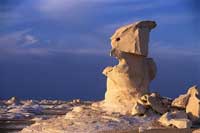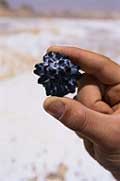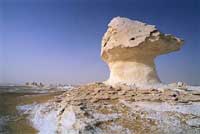|
Farafra, known as
Ta-iht or the Land of the Cow in pharaonic times, is a single
village. The most isolated of the New Valley Oases it is
renowned for its strong traditions and piety. According to
folklore, the villagers once lost track of time and had to send
a rider to Dakhla so they could hold the Friday prayers on the
right day. The oldest part of the village, on a hillside, is
next to peaceful walled palm groves; a short ride away there are
hot sulphur springs at Bir Setta and swimming at El-Mufid Lake.
 Mostly inhabited by Bedouins, the small mud-brick houses all
have wooden doorways with medieval peg locks. As in other oases,
many of Farafra's houses are painted blue (to ward off the Evil
Eye) but here some are also decorated with landscapes, birds and
animals, the handiwork of local artist, Badr. A combination
house, museum and studio exhibiting his paintings and ceramics
is situated in a garden full of sculptures made from objects
found in the surrounding desert. Mostly inhabited by Bedouins, the small mud-brick houses all
have wooden doorways with medieval peg locks. As in other oases,
many of Farafra's houses are painted blue (to ward off the Evil
Eye) but here some are also decorated with landscapes, birds and
animals, the handiwork of local artist, Badr. A combination
house, museum and studio exhibiting his paintings and ceramics
is situated in a garden full of sculptures made from objects
found in the surrounding desert.
The only real village in the Farafra Oasis, Qasr Al Farafra is a
quite and relaxing place, which represents most of what it has
to offer tourists. There are few tourist accommodations in the
area, but that may change in the near future. Most of the
description of the Farafra Oasis applies to the town itself.
The White Desert ,20 km from Farafra on the Highway between
Farafra and Bahariya, is one of the most exiting places. A
surreal landscape of fungoid shapes that glint pale gold in the
midday sun and turn pink and violet around dusk, resembling
icebergs at dawn and snowdrifts by moonlight, the chalk outcrops
loom over dusty ground littered with fossils, quartz crystals
and iron pyrites shaped like sea-urchins or twigs. Herds of
gazelles may be glimpsed at daybreak, when they forage for a
couple of hours.
Of those with an interest in Egypt, and particularly the Western
Oasis, the Farafra is probably one of the least known Oasis. It
is actually one of the most difficult Oasis to reach and offered
the pharaohs, caliphs and kings very little, though it seem to
be on the way to everywhere.
 There is actually very little known of the Farafra Oasis prior
to the Roman period, and even of that period only a few remains
have been found. While the oasis offers a stunning desert
landscape, there is little in the way of antiquities to see.
According to a statue of the 5th Dynasty, Farafra, as well as
the Bahariya Oasis were probably a part of the Egyptian empire
during the Old Kingdom. It was known as the Trinitheos, Ta-ihw,
and the Land of the Cow (in reference to Hathor). It was often
invaded whenever the Libyans decided to attack Egypt, being on
their way to the Nile Valley. Though we have little idea what
the reference refers to, the text known as the Eloquent Peasant
refers to the "rods of Farafra" in relationship to produce,
giving us at least a citation to the oasis during the First
Intermediate Period. There is actually very little known of the Farafra Oasis prior
to the Roman period, and even of that period only a few remains
have been found. While the oasis offers a stunning desert
landscape, there is little in the way of antiquities to see.
According to a statue of the 5th Dynasty, Farafra, as well as
the Bahariya Oasis were probably a part of the Egyptian empire
during the Old Kingdom. It was known as the Trinitheos, Ta-ihw,
and the Land of the Cow (in reference to Hathor). It was often
invaded whenever the Libyans decided to attack Egypt, being on
their way to the Nile Valley. Though we have little idea what
the reference refers to, the text known as the Eloquent Peasant
refers to the "rods of Farafra" in relationship to produce,
giving us at least a citation to the oasis during the First
Intermediate Period.
During the New Kingdom there is somewhat more evidence that
comes to us from the Farafra Oasis. A stela was discovered in
the Oasis dating to the 18th Dynasty, but it provides little
information. However, we find documentary records from the reign
of Ramesses II in the Temple of Luxor that he received precious
stones form Farafra that were used in some of his extensive
building works along the Nile Valley. However, the references
does not provide information on the type of stones, and no
evidence of ancient mining activities have so far been unearthed
in the oasis. What is known is that during the 19th Dynasty
reign of Merenptah, Ramesses II's son and successor, the oasis
was captured by Libyan invaders who used it as a base to attack
the Nile Valley. As a side note, the Farafra Oasis is actually
closer to Libya than to the Nile Valley.
During the Third Intermediate Period, though little supporting
evidence is available, the Farafra may have been an important
way station for both armies and trade caravans. We do know that
there were several major caravan routes that operated through
the Farafra during this period.
Though the quantity is small, the earliest antiquities currently
found in the Farafra Oasis date from the Roman Period. During
that time, it probably held some real importance for the Romans
because it sat at the center of their African holdings,
connecting the Nile Valley to the Libyan oasis such as Jalo and
Kufra. So far, the Roman antiquity sites found in the Oasis are
actually at Ain Della, now often called the "Hidden Valley",
which is actually a separate depression just north of Farafra,
with others found at Wadi Hinnis along the main caravan route to
the Bahariya Oasis, and at Ain Besay just to the south of Qasr
Farafra.
 During the Roman Byzantine Period, the oasis mostly converted to
Christianity and remained Christian far into the Islamic era,
even though it was, the first Western Desert oasis conquered by
the Arabs. Little evidence exists that it became a place of
banishment like the Siwa and Kharga Oasis, but it is likely to
have been, given its remote location. We do find a number of
Coptic inscriptions in the oasis, as well as clearly Christian
houses and cemeteries dating to the 10th century. During the Roman Byzantine Period, the oasis mostly converted to
Christianity and remained Christian far into the Islamic era,
even though it was, the first Western Desert oasis conquered by
the Arabs. Little evidence exists that it became a place of
banishment like the Siwa and Kharga Oasis, but it is likely to
have been, given its remote location. We do find a number of
Coptic inscriptions in the oasis, as well as clearly Christian
houses and cemeteries dating to the 10th century.
Actually, the Islamic religion did not enter the Farafra Oasis
from the Nile Valley, but rather from North Africa. Our first
reference of the oasis during the early Islamic period is the
Kitab al-buldan by al-Yaqubi written during the 9th century. It
says of the Farafra that the oasis was inhabited by people of
"all descents". This document was written at about the time that
the oasis began to be converted to the Islamic faith.
The Arab rulers of Egypt maintained a relatively large army in
the desert. Unfortunately, this was a difficult period for many
people in the Western Oasis, and like elsewhere, the Farafra was
almost depopulated by the Mamluk rule of Egypt.
Today, Farafra has not just entered the new world, though its
essence remains elusive and mysterious, the oasis is scheduled
to add new chapters to world history. As a part of the visionary
New Valley Project, soon Farafra will change forever. With many
incentives for Egyptian families to move to the New Valley in
order to elevate overcrowding in current urban centers, there
are many more villages in or near the Oasis , and each is
provided with a school, a hospital and a mosque. Industry is
also arriving in the oasis in the form of Fiber optics!
The Farafra is also being developed for tourism, and while there
are few ancient artifacts in the region, the desert is
wonderfully diverse. |